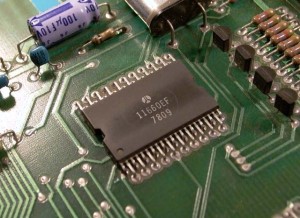 Antique microprocessors are classified as one of four types of devices: single-chip processing units (ex. Intel 4004), multi-chip processing units (Fairchild 3850), multi-chip bit-slice units (ex. AMD 2901), and single-chip microcomputers, also called microcontrollers (ex. TI TMS1000). Modern technology also includes a type that has an entire computer system-on-chip. Collectors sometimes don’t distinguish between the types in their collection, but it is important to know the differences. If you are collecting a multi-chip microprocessor, it would be nice to have all the chips that provide the functions of a microprocessor (ex. Fairchild 3850 & 3851).
Antique microprocessors are classified as one of four types of devices: single-chip processing units (ex. Intel 4004), multi-chip processing units (Fairchild 3850), multi-chip bit-slice units (ex. AMD 2901), and single-chip microcomputers, also called microcontrollers (ex. TI TMS1000). Modern technology also includes a type that has an entire computer system-on-chip. Collectors sometimes don’t distinguish between the types in their collection, but it is important to know the differences. If you are collecting a multi-chip microprocessor, it would be nice to have all the chips that provide the functions of a microprocessor (ex. Fairchild 3850 & 3851).
Microprocessors are often implemented on one piece of silicon (monolithic) and are comprised on two major logical sets of circuitry the control unit (CU) and the arithmetic and logic unit (ALU). The CU controls the actions of the CPU and the ALU does the math and logic functions. The CU is designed to accept instructions, decode them, and send the appropriate signals to the ALU to execute the instruction. Microcomputer have CUs and ALUs, but also include memory as well.
